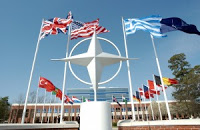Madison Ruppert, Contributing Writer
Activist Post
Recently I wrote a relatively exhaustive article on the geopolitical maneuvering being carried out by the United States and the North Atlantic Treaty Organization (NATO), which is now engaging in activities far beyond that which it was created to do.
This is part two of what will likely become a long-running series covering these global developments and the implications thereof.
Unfortunately, most of the news is presented in bite-sized portions which purposefully do not connect the clearly relevant events in order to present the average reader with a better understanding of what it all means, which is exactly why I’m writing these articles in an attempt to counter this method of disinformation. This disjointed method of presenting information allows for compartmentalization and an artificial separation of issues which are all clearly part of a greater trend.
It now appears that the West – and thus the United States and NATO at the forefront – is attempting to isolate a group of countries that includes as the most major constituents Russia and China.
This is being done through a multi-pronged approach which lends itself to being hidden under the guise of random events and developments that are not officially related.
Of course, once one aggregates all of these issues as I have done, it becomes quite clear that they are all indeed part of a greater push around the world.
This includes a significantly greater presence in the Asia-Pacific region to stifle China and/or goad the large nation into engaging in hostilities over the South China Sea dispute, which would justify a brutal Western assault.
There is also an effort to bring Eastern European nations into NATO and expand the so-called Anti-Ballistic Missile (ABM) system in the region, which raises the ire of Russia just as the South China Sea issue does with the Chinese.
Georgia
There seems to be a significant push to bring Georgia into NATO, which is quite noteworthy due to the fact that Georgia shares its largest border with Russia.
Not to mention that relations between Georgia and Russia are shaky at best after the so-called “Rose Revolution” in 2003, especially when it comes to the conflicts over South Ossetia and Abkhazia, most notably during the Russo-Georgian War of 2008, also known as the 2008 South Ossetia War.
2011 has been an eventful year in terms of Georgia’s move to integrate into NATO and the European Union, according to Georgia’s Deputy Prime Minister Giorgi Baramidze.
This includes the successful utilization of a “NATO-Georgia Commission” which Baramidze says has already resulted in 20 meetings and thus a closer relationship between the US-led alliance and Georgia.
“NATO Secretary General’s visit to Georgia and mentioning Georgia among countries – candidates for Alliance’s membership were important,” Baramidze said, as reported by Azerbaijani Trend News Agency.
He emphasized that this was the first time and that the decision made at the NATO summit in Bucharest saying that Georgia would become a NATO member still holds true.
Baramidze said that Georgia will be aiming to maintain a “high rate of integration into the NATO and EU,” during 2012.
He stated that the negotiations on an association agreement between the European Union and Georgia are important and must continue, including discussions on free trade and visas.
“Georgia expects [a] clearer signal on which steps should be taken for closer approximation,” Trend quotes Baramidze as saying, although the translation seems to be a bit off.
 Georgian troops have also been acquiring experience on the hellish battleground that is Afghanistan, which they – or at least Georgia’s government – relish.
Georgian troops have also been acquiring experience on the hellish battleground that is Afghanistan, which they – or at least Georgia’s government – relish.
Recently Georgia’s Defense Minister Bacho Akhalaya visited Afghanistan to praise the Georgian contingent deployed there and meet with NATO commanders.
He met with the commanders of the International Security Assistance Force (ISAF), the American commanders and stated that, “The NATO command in Afghanistan has told me once again about the highest marks given to the Georgian contingent’s actions. Certainly, it inspires pride in the country and our servicemen,” according to Interfax.
The Georgian President Mikheil Saakashvili has also recently made some quite strong statements about Russia, including the prediction that the Russian “empire will inevitably fall” and thus Georgia would be “liberated.”
He made these proclamations during a New Year message to the nation, noting that he considered 2011 “an important year for Georgia” during which they “achieved serious progress in many directions.”
“In 2008 our enemy [Russia] thought that [Georgia] was leveled to the ground, but in recent years an opinion has been firmly established throughout the entire post-Soviet space – in Ukraine, in Central Asia, among our neighbors and even in Russia – that Georgia is an absolute leader in terms of carrying out reforms and fighting corruption,” Georgian President Saakashvili said.
Saakashvili also touched on the prospect of Georgia becoming a full member in the EU, although Civil Georgia’s coverage makes no mention of NATO.
Saakashvili stated that in 2011 “everyone in the European Union seriously started [saying] that Georgia should become in following years [a] full-fledged member of the EU and this is a real geopolitical revolution.”
Indeed it would be a huge boon for the West to bring Georgia into the EU and NATO, while exerting more control over the nation and leveraging its strategic position near Russia, along with putting Georgia into increased receivership and dependence.
China’s Xinhua also recently published a piece speculating about the South Caucuses being a spot in which another crisis could emerge, especially seeing that will likely serve as a pipeline after Western troops (supposedly) leave Iraq.
Azerbaijan
The Georgian integration dovetails with the efforts to bring Azerbaijan into the sphere of the United States and thus NATO along with the rest of Eastern Europe.
Azerbaijan is also becoming increasingly chummy with the Western powers, most notably the United States, which is inseparable from NATO and NATO from it.
According to Trend, both the Azerbaijanis and NATO have endorsed the third stage of a pact which was first signed in 2005.
The third stage of the Individual Partnership Action Plan, or IPAP, between NATO and the small country of Azerbaijan, relatively close to Russia, covers cooperation between the alliance and the Azerbaijani government throughout 2012 and 2013.
Trend states that the IPAP covers four sections but then lists a great deal more than four issues which the agreement covers.
The sections they list are: politics and security, defense and military issues, public information, civil emergency planning, science and environmental issues, administrative issues, security of information, resources and legal issues, which seems pretty comprehensive in scope.
Given that phase one and two of the IPAP have already been successfully implemented, it is only logical to assume that stage three will be similar, especially since Trend says that the first two phases “were highly appreciated at various levels by NATO officials.”
Azerbaijan is far from alone in having an IPAP in place in the region, indeed the alliance is pushing for increased integration with most of Eastern Europe in order to further encircle Russia and strengthen regional ties.
Currently the following nations have IPAPs implemented (in order of signing from earliest to most recent): Ukraine, Georgia, Azerbaijan, Armenia, Kazakhstan, Moldova, Bosnia and Herzegovina and Montenegro in 2008.
It was also announced by the Azerbaijani Defense Ministry’s press service on December 30 that Azerbaijan and the United States will be holding bilateral military consultations on January 12-13.
 These meetings will be held in Washington and the issues being discussed are not public according to the Azeri-Press Agency (APA).
These meetings will be held in Washington and the issues being discussed are not public according to the Azeri-Press Agency (APA).
This begs the question: what is being discussed that is too sensitive to publicize? If it is just matters surrounding the third phase of the IPAP, surely these matters should be public given that they involve the people of both Azerbaijan and America alike?
Even if the meeting is totally innocent and the subjects being discussed are harmless, it is surely going to do little to allay Russia’s concerns when a nearby nation is engaging in closed-door discussions with the United States, especially if the discussions touch on the ABM system.
Oddly enough, the APA reported on the Commander in Chief of the Oklahoma National Guard Myles Deering’s visit to Azerbaijan last December.
In an interview Deering stated that he had met with Azerbaijani Defense Minister Safar Abiyev, noting, “we have a lot of similarities. That is the reason why Oklahoma [is] a partner of Azerbaijan. Because Azerbaijan has the oil and natural resources as [does] Oklahoma.”
It is quite clear that the United States is pushing to integrate Azerbaijan tightly into the NATO framework, even if just under the guise of the IPAP.
Japan-India-Philippines-Australia
The majority of the previous installment was spent discussing the intricate web of relations in the Asia-Pacific region that is bringing together the United States with Japan, India and Australia.
These ties are all multilateral and complex but all are indeed troubling to those who relish peace, along with those whose objections might not be so pure of heart, like China – which is far from a guilt-free nation when it comes to these dastardly machinations.
The state-run media out of China has been expressing some serious concerns over the decision to lift the self-imposed Japanese ban on the arms trade and the increasingly tight integration of the Japanese and Indian militaries.
Not to mention the fact that Australia will be providing nuclear materials to India – a factor I covered in the previous installment, which you truly must read if you have yet to do so – and the American military presence in the region is getting a major upgrade.
There are also concerns over Japanese arms experts to the Philippines, which also just received a patrol vessel from the United States Coast Guard to be deployed in a region relatively close to the disputed South China Sea.
As I previously said, while there are regions of the Philippines that are closer than Palawan Island where it is being deployed, the ship is capable of carrying out a month-long mission so travel to the South China Sea would be no problem.
However, currently it is patrolling the rich Malampaya Oil Fields and other areas to the west of the Palawan province, although this is not likely to make China too happy even if it is totally innocuous.
Liu Jianyong, a man described as an expert on Japan studies at Tsinghua University, points out that the lifting of the arms ban allows for the export of arms to Japan’s neighbors and allies which will at first be done under the auspices of maritime security.
“But offensive weapons may eventually enter the picture, because that’s the only way to fuel its indigenous defense industry,” he said.
This is quite true as like every industry, the market needs to continue to expand in order for profit to grow and once the need for all defense maritime security equipment is met, there will still need to be more sales.
Therefore, it is only logical that Japanese contractors, like their American counterparts, will continue to create equipment even though there is actually no real need for it.
Liu states that in the long-term this Japanese policy shift will prove to be detrimental for China, especially when the inevitable maritime disputes arise.
“When these countries engage in maritime disputes with China – that’s when the impact of this policy may come to affect us,” he said.
 It isn’t too hard to understand why China might see themselves as a potential target of the rapidly developing partnerships in the Asia-Pacific region, which will likely serve to increase the already significant tensions.
It isn’t too hard to understand why China might see themselves as a potential target of the rapidly developing partnerships in the Asia-Pacific region, which will likely serve to increase the already significant tensions.
Zhao Gancheng, the director of the South Asia research department at the Shanghai Institute for International Studies, stated that Indian-Japanese arms trade may indeed make tensions even stronger in the region because of China’s status as a potential – if not likely – target.
Zhao sees this as a contradiction because while Japan “wants to counter china by linking with countries such as the US, India and Australia … it is aware of the fact that Sino-Japanese relations are a prerequisite for its quest to become a normal country.”
“So personally, I think the policy is itself contradictory,” Zhao added.
Zhao’s point was underlined by the announcement on December 26 that China and Japan have agreed to begin direct trading of their currencies, although chances are that Zhao is attempting to say that the Japanese are being contradictory but not the Chinese.
It was also said that Japan would be applying to buy Chinese bonds in 2012 after Japanese Prime minister Yoshihiko Noda met with Chinese President Hu Jintao.
This seemingly oxymoronic relationship is quite interesting, seeing that Japan seems to be drawing military and diplomatic support from one side, while increasing economic ties on the other while the relationships are ostensibly contradictory.
This is one of the many cases that makes me wonder if all of this geopolitical maneuvering very well might be pure theatrics in an attempt to distract the public from the fact that the most powerful nations of the world are in fact working together towards total economic hegemony due to the ruling elite in all nations having the same interests.
Of course, this is pure speculation and the growing tension in the region does have all the hallmarks of a real conflict in the making.
Then again, the defense industry requires perpetual war, so it very well might be the case that the powers controlling the governments of these nations are pushing their countries towards war, while making sure that their economic hegemony remains unchallenged in order to ensure future profits.
Afghanistan-Pakistan (often referred to as AfPak or Af-Pak)
Relations between Pakistan and NATO are, to say the least, unstable at this point. While the strain is nothing quite new, it has become considerably worse after NATO aircraft invaded Pakistani airspace and killed 24 Pakistani troops on November 26.
This led to the Pakistanis demanding that the Shamsi military base be vacated and a complete halt on drone strikes, along with restrictions on the transfer of military supplies which contributed to a $400/gal. price tag on gasoline in Afghanistan, which of course the American taxpayer is put on the hook for.
This is evidenced by the Pakistani refusal to allow new American drone bases on their sovereign territory.
This is leaving the United States searching for more locations in central Asia and Afghanistan from which to launch their deadly drones.
Currently the United States is operating seven drone bases in Pakistan, one of which is run by the Central Intelligence Agency (CIA) while the rest are joint operations between the Army, Air Force and Navy.
Anonymous officials have stated that the United States is currently considering additional covert military bases in central Asia in order to continue the controversial drone strikes in Pakistan against alleged militants.
However, it appears that they are meeting some resistance as the Central Asian Republics (CARs) have reportedly refused to allow bases to be built due to pressure from Russia.
It seems quite likely that this will act as yet another issue which weighs on the strained ties between NATO and Russia, as it has become clear that the West truly does not appreciate any opposition whatsoever, no matter how legitimate it may be.
The drone program in Pakistan has killed an estimated 3,659 people since 2004, including civilians and suspected militants.
In 2011 alone, 78 attacks killed about 607 people and 306 strikes have occurred since 2004 according to the Conflict Monitoring Center (CMC), a think tank based out of Islamabad, Pakistan which monitors conflict scenarios in South Asia.
The numbers provided by the Long War Journal are slightly different and are broken down in more detail at the link cited.
Abdullah Khan, the director of the CMC told Pakistan’s The Nation that the American drone program is “not as convenient and easy as it used to be. There are too many operational constraints involved in launching drone strikes from Khost compared to Shamsi.”
“Secondly, given that Pakistan has completely disrupted intelligence sharing on drones, it’s next to impossible for them (CIA) to continue with drones here,” Khan added.
The Khost provincial government spokesman Mubarez Zadran expressed ignorance as to the presence of covert military bases for drones in the province, which The Nation rightly points out is “something nobody would want to speak on,” given the thick veil of secrecy under which they operate.
Similarly, the United States embassy in Islamabad and NATO do not officially comment on the CIA’s drone program and NATO’s officials in Afghanistan deny any involvement with drone strikes in Pakistan.
Russia continues to disagree with the sustained presence of the United States and NATO in Afghanistan, and it looks unlikely that it is going to change any time soon if the loya jirga in November is any indication.
The Nation reports that United States Secretary of State Hillary Clinton’s October visit to Pakistan came on the heels of “a secretive agreement on drones as part of the renewed military Pak-US cooperation after a spree of hostility.”
“Unearthed by The Nation on October 22nd, the agreement envisaged resumption of intelligence cooperation between Pakistan’s Inter-Services Intelligence (ISI) and CIA for hunting down the militants on both sides of the border,” they added.
There is also the matter of strategic partnerships between Afghanistan and the European nations of England, France and Italy.
French Defense Minister Gerard Longuet announced that French armed forces would remain in Afghanistan post-2014 yesterday with Pajhwok Afghan News reporting that strategic agreements with England and Italy were also announced by Janan Musazai, the spokesman for the Afghan Ministry of Foreign Affairs.
Musazai stated that more discusses regarding the proposed Afghan-American strategic agreement needed to be held, while Pajhwok Afghan News points out that the accord was discussed originally at the loya jirga almost two months ago.
“The delegates gave a conditional green signal to the agreement allowing the Americans to establish military bases in Afghanistan,” they report.
The mainstream Western media has been conspicuously silent on this and continues to pretend that the rapidly approaching date of 2014 will be honored by any of the major players, which is a wholly laughable assertion.
As is the case with Japan’s security ties pulling one way and economic ties with China pulling in another, it appears that Afghanistan is attempting to balance their relations with the United States with Iran and other nations with seemingly opposing interests like Russia and China.
This was highlighted by the deal with Europe’s contrast with the fuel agreement between Afghanistan and Iran and the recent Afghan oil deal with China National Petroleum Corp (CNPC).
It is also quite interesting that the United States just acquired the “Avenger” Unmanned Aerial Vehicle (UAV), or drone, which is being billed as the largest and fasted hunter-killer drone ever, built by General Atomics Aeronautical Systems Inc., the same company behind the MQ-1 Predators and MQ-9 Reapers.
This is odd given that drone operations in Pakistan are seemingly going to become more difficult, although it could very well be flying out of one of the many new secret drone bases which will be used to launch incursions into Somalia and Yemen and possibly other locales.
There is also the worrisome possibility that the so-called Predator C could be used against us here at home given that the domestic use of drones is increasing at a disturbing pace.
However, I find this highly unlikely given that the newest model evades radar, travels at 460 miles per hour and can carry a payload of up to 15,800 pounds which translates to a great deal of firepower.
The expansion of the drone program both inside and outside the United States is troubling for me and many others due to the fact that there are actually civilians in the so-called “kill chain” and drone pilots can be operating up to four drones at once with little training compared to traditional aircraft.
Drone pilots require less than 25% of the training that normal pilots receive, 44 hours instead of 200 to be exact.
There is also the matter of the immense number of personnel required to run the drones. Keeping a Predator in the air for 24 hours requires a whopping 168 people, while the Global Hawk needs 300, according to the Air Force.
This is quite a large figure compared to the 100 personnel required for a mission on with an F-16 fighter jet, although the Los Angeles Times doesn’t make it clear if that is also for a 24-hour period or for a shorter mission.
The constant expansion of the drone program defies logic yet is unquestioned, for the same reason that I discussed earlier in the case of Japan.
The so-called defense contractors need to make money, and in order to do so they need to continue to receive government funds which can only be done by providing a product.
This requires perpetual conflict and a war with no end, which is exactly what the “War on Terror” happens to be.
The expansion of NATO and Western hegemony is not an issue that is going away any time soon and thus I will have no choice but to continue to cover this as much as possible.
All of the geopolitical rumblings we are witnessing at this point seem to be pointing in one direction: conflict. There is an undeniable trend towards encircling China and Russia, isolating them while of course continuing to do business.
I cannot be sure if all of this is purely superficial, or if there is actually a fundamental schism between the West along with the nations being swallowed up by its influence and nations like Russia, China and Iran; or, if it is just being done to continue to manufacture a need for one of the world’s most profitable industries: war.
I need feedback and information to continue to write these articles as best as possible, so if you have anything to share please do not hesitate to contact me at Admin@EndtheLie.com with anything and everything you have.
This article first appeared at End the Lie
linkwithin_text=’Related Articles:’





Be the first to comment on "U.S. and NATO are on the march worldwide – part II"